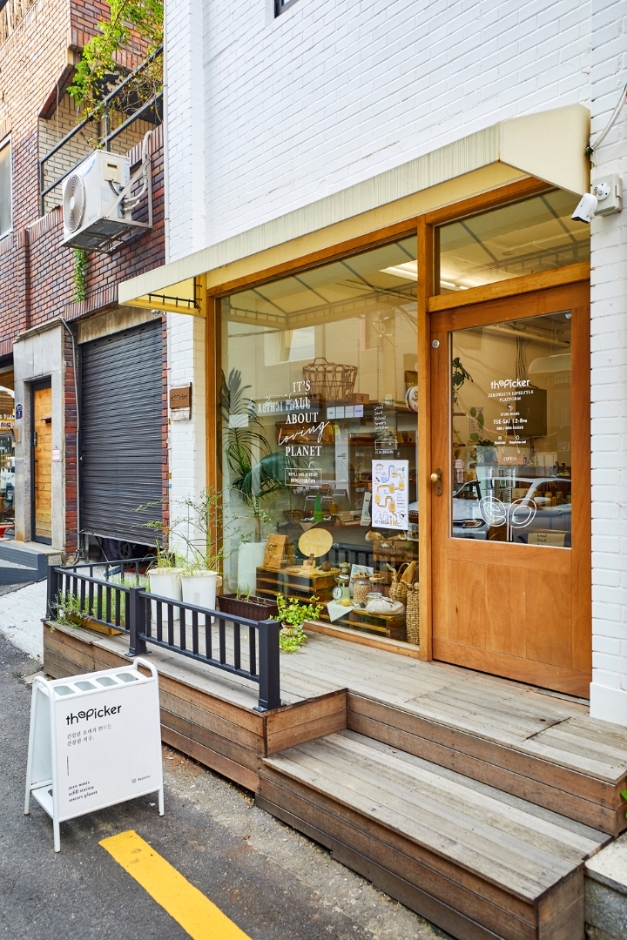Galaxy Lifestyle - Lotte Cheongnyangni Branch [Tax Refund Shop] (갤럭시라이프스타일 롯데 청량리점)
6.1Km 2024-04-19
5F, 214, Wangsan-ro, Dongdaemun-gu, Seoul
-
Beanpole - Lotte Cheongnyangni Branch [Tax Refund Shop] (빈폴 롯데 청량리점)
6.1Km 2024-04-23
5F, 214, Wangsan-ro, Dongdaemun-gu, Seoul
-
J.Estina - Lotte Cheongnyangni Branch [Tax Refund Shop] (제이에스티나 롯데 청량리점)
6.1Km 2024-04-18
214, Wangsan-ro, Dongdaemun-gu, Seoul
-
Adidas - Lotte Cheongnyangni Branch [Tax Refund Shop] (아디다스 롯데 청량리점)
6.1Km 2024-04-19
6F, 214, Wangsan-ro, Dongdaemun-gu, Seoul
-
Lotte Himart - Cheongnyangni Branch [Tax Refund Shop] (롯데하이마트 청량리점)
6.1Km 2024-04-18
214, Wangsan-ro, Dongdaemun-gu, Seoul
-
The Picker (더피커)
6.1Km 2024-01-05
9 Wangsimni-ro 14-gil, Seongdong-gu, Seoul
The Picker is Korea's first zero-waste shop that opened in 2016, and has a sophisticated and comfortable atmosphere. The shop is filled with eco-friendly bathroom products, gardening products, kitchen products, stationery, and more. It is fun to look around as it has many products essential to everyday life made from very environmentally friendly materials such as bamboo toothbrushes, solid perfume, shampoo bars, plastic-free corn floss, natural surfactants like soapnut fruits, and glass and silicone straws.
Seoul Forest (서울숲)
6.1Km 2024-10-29
273 Ttukseom-ro, Seongdong-gu, Seoul
+82-2-460-2905
Seoul Forest is a city park opened on June 18, 2005 in what was originally a water treatment facility. Consisting of four themed parks spread over approximately 595,000 ㎡ of land, Seoul Forest is an eco-friendly zone appreciated not only by the people of the city but also those visiting Seoul.
Himart - Eunpyeong Branch [Tax Refund Shop] (하이마트 은평점)
6.2Km 2024-04-22
148, Eunpyeong-ro, Eunpyeong-gu, Seoul
-
LG Best Shop - Eunpyeong Branch [Tax Refund Shop] (엘지베스트샵 은평점)
6.2Km 2024-04-18
153, Eunpyeong-ro, Eunpyeong-gu, Seoul
-
![Galaxy Lifestyle - Lotte Cheongnyangni Branch [Tax Refund Shop] (갤럭시라이프스타일 롯데 청량리점)](http://tong.visitkorea.or.kr/cms/resource/50/2890150_image2_1.jpg)
![Beanpole - Lotte Cheongnyangni Branch [Tax Refund Shop] (빈폴 롯데 청량리점)](http://tong.visitkorea.or.kr/cms/resource/52/2890152_image2_1.jpg)
![J.Estina - Lotte Cheongnyangni Branch [Tax Refund Shop] (제이에스티나 롯데 청량리점)](http://tong.visitkorea.or.kr/cms/resource/89/2890189_image2_1.jpg)
![Adidas - Lotte Cheongnyangni Branch [Tax Refund Shop] (아디다스 롯데 청량리점)](http://tong.visitkorea.or.kr/cms/resource/20/2890220_image2_1.jpg)
![Lotte Himart - Cheongnyangni Branch [Tax Refund Shop] (롯데하이마트 청량리점)](http://tong.visitkorea.or.kr/cms/resource/50/2890450_image2_1.jpg)


![Himart - Eunpyeong Branch [Tax Refund Shop] (하이마트 은평점)](http://tong.visitkorea.or.kr/cms/resource/68/2889968_image2_1.jpg)
![LG Best Shop - Eunpyeong Branch [Tax Refund Shop] (엘지베스트샵 은평점)](http://tong.visitkorea.or.kr/cms/resource/76/2890276_image2_1.jpg)
 English
English
 한국어
한국어 日本語
日本語 中文(简体)
中文(简体) Deutsch
Deutsch Français
Français Español
Español Русский
Русский